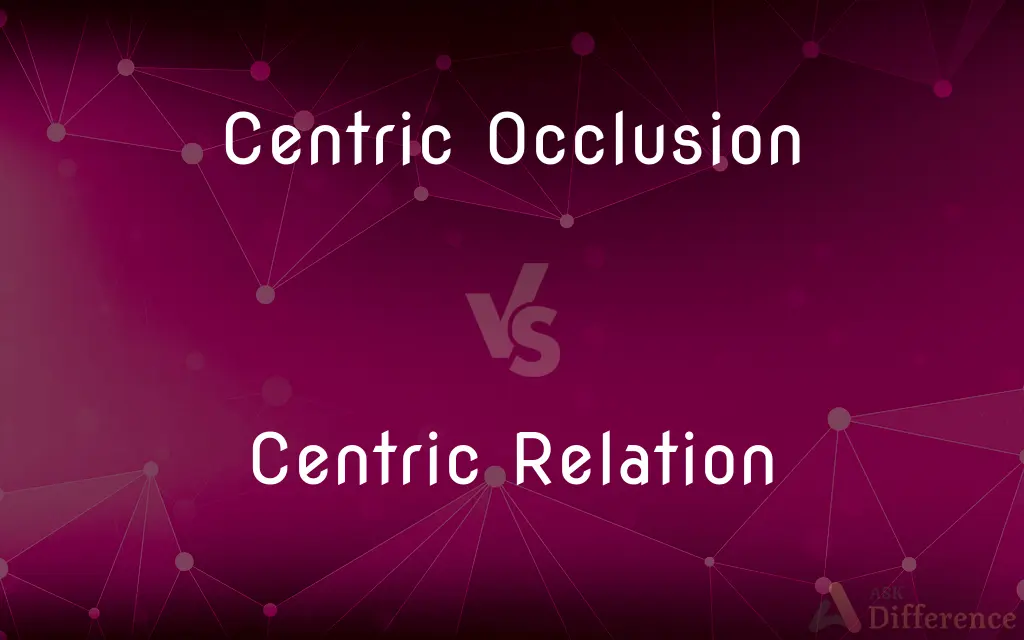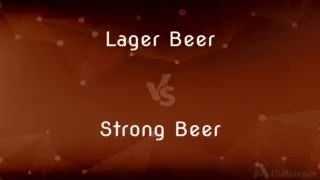Centric Occlusion vs. Centric Relation — What's the Difference?
By Tayyaba Rehman — Published on November 21, 2023
Centric Occlusion refers to the natural contact of upper and lower teeth when jaws are closed. Centric Relation is the jaw's position where both joint heads are seated in their most upward and backward position.

Difference Between Centric Occlusion and Centric Relation
Table of Contents
ADVERTISEMENT
Key Differences
Centric Occlusion pertains to the alignment and contact of the upper and lower teeth when the jaws are closed. It's essentially the position where your teeth fit together when you bite down naturally. Centric Relation, conversely, is not necessarily about the teeth but the position of the jaw. It signifies the most anterior and superior position of the condyle (joint) in the joint space.
When dentists evaluate a person's bite or plan for procedures like restorations, they look at Centric Occlusion to see how the teeth come together. It is essential for understanding the functional aspect of a person's bite. Centric Relation, however, is more of a reference position used to analyze and diagnose discrepancies between the natural bite and the jaw's ideal position.
Centric Occlusion is significant because a misaligned bite can lead to several dental problems, including tooth wear, breakage, and pain in the jaw. When dentists aim to perfect a person's bite, they look at this alignment. On the other hand, Centric Relation is a constant, unchanging position that allows dentists to determine if there's a deviation from the ideal bite, helping in treatment planning.
In many cases, there may be a discrepancy between Centric Occlusion and Centric Relation. When the natural bite does not align with the jaw's ideal position, it can lead to issues like temporomandibular joint disorder (TMD). Recognizing the differences between these two terms allows dental professionals to treat and address such discrepancies effectively.
Comparison Chart
Reference to
Teeth
Jaw Position
ADVERTISEMENT
Significance
Natural bite
Ideal jaw position
Usage in Dentistry
Evaluate bite alignment
Reference for diagnosing bite discrepancies
Associated Issues if Misaligned
Tooth wear, breakage, jaw pain
Temporomandibular joint disorder (TMD)
Changeability
Can change due to dental procedures or wear
Consistent and doesn't change
Compare with Definitions
Centric Occlusion
The natural fitting together of teeth when biting.
Centric occlusion discrepancies can lead to dental issues.
Centric Relation
The ideal position of the jaw where both joints are seated correctly.
He had a deviation from the centric relation, leading to TMD symptoms.
Centric Occlusion
The alignment of teeth when the jaws are closed.
The dentist noted the patient's centric occlusion was off due to a misaligned tooth.
Centric Relation
The jaw position where the joint heads are most upward and backward.
She learned that her jaw's centric relation did not align with her natural bite.
Centric Occlusion
The contact position of upper and lower teeth in full bite.
His centric occlusion caused discomfort while chewing.
Centric Relation
The unchanging position of the jaw irrespective of teeth.
The dentist used the centric relation to diagnose her bite discrepancy.
Centric Occlusion
The position where teeth exhibit maximum contact.
The orthodontist aimed to achieve perfect centric occlusion for the patient.
Centric Relation
The most anterior-superior position of the condyle in the joint.
Centric relation is a critical reference for many dental treatments.
Centric Occlusion
The optimal position of molar teeth during jaw closure.
Adjustments were made to improve her centric occlusion after braces.
Centric Relation
The skeletal relationship of the upper and lower jaw.
Using centric relation, the orthodontist planned her treatment strategy.
Common Curiosities
Can Centric Occlusion be adjusted?
Yes, Centric Occlusion can be adjusted using dental treatments like orthodontics.
What does Centric Occlusion refer to?
Centric Occlusion refers to the natural contact of upper and lower teeth when jaws are closed.
What is the significance of Centric Relation?
Centric Relation provides a reference for the jaw's ideal position, crucial for diagnosing bite discrepancies.
Why is recognizing Centric Occlusion important in dentistry?
Recognizing Centric Occlusion helps in evaluating bite alignment, crucial for treatments and ensuring oral health.
Can wear and tear affect Centric Occlusion?
Yes, factors like tooth wear can impact Centric Occlusion over time.
How is Centric Relation used in treatment planning?
It's used as a reference to determine deviations from the ideal bite, guiding treatments.
Is Centric Relation dependent on teeth alignment?
No, Centric Relation is a consistent jaw position, regardless of teeth alignment.
Can a discrepancy between Centric Occlusion and Centric Relation cause discomfort?
Yes, discrepancies can lead to issues like TMD, causing pain and discomfort.
Is Centric Relation the same for everyone?
While the concept remains consistent, individual anatomy can lead to slight variations in Centric Relation.
How do orthodontists use Centric Occlusion in their work?
Orthodontists use Centric Occlusion as a guide to achieve optimal teeth alignment and bite functionality.
Share Your Discovery

Previous Comparison
Lager Beer vs. Strong Beer
Next Comparison
Merry Christmas vs. Happy HolidaysAuthor Spotlight
Written by
Tayyaba RehmanTayyaba Rehman is a distinguished writer, currently serving as a primary contributor to askdifference.com. As a researcher in semantics and etymology, Tayyaba's passion for the complexity of languages and their distinctions has found a perfect home on the platform. Tayyaba delves into the intricacies of language, distinguishing between commonly confused words and phrases, thereby providing clarity for readers worldwide.













































